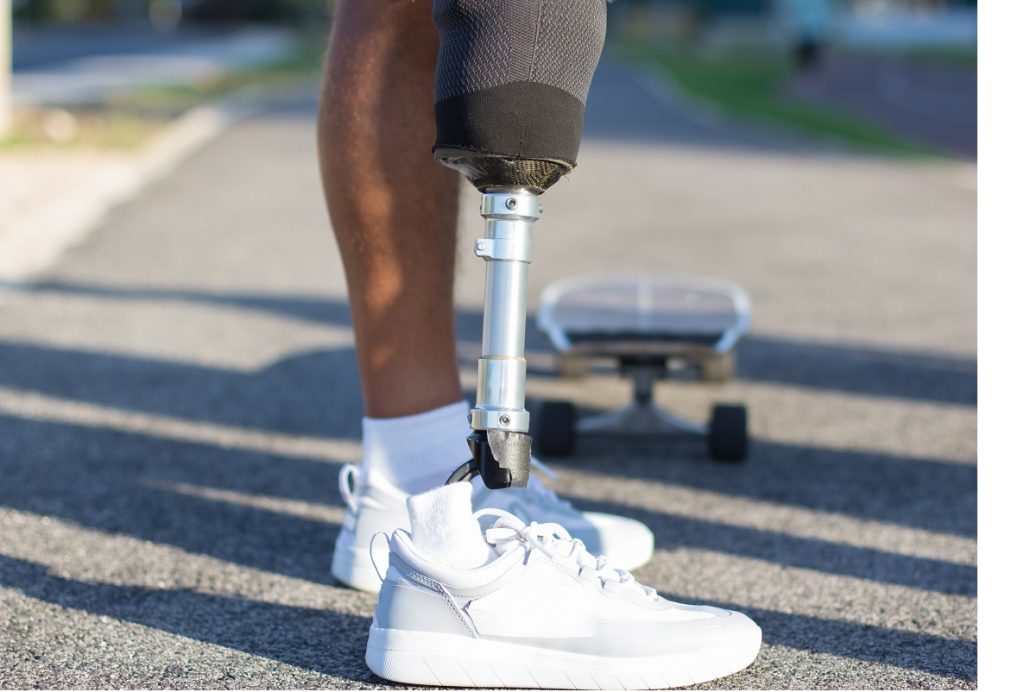by Alexandra Boutté

Like most amputees (especially lower-limb amputees), I tend to struggle when it comes to shoe shopping. What once felt like a treat now feels like paying taxes. I bring a buddy for moral and physical support, hop around (literally) from store to store, and hope for the best.
Thanks to some outspoken members of our community, a few shoe manufacturers have heard our cries of distress. First and foremost, Mathew Walzer’s plea to Nike led to the creation of the FlyEase, and two limb-different Nike employees got the assignment of their lives when they took on the task of creating a cool-looking shoe that would work for people with all kinds of disabilities, including upper-limb and lower-limb difference. The product was enough of a game-changer to land on Time‘s list of top innovations in 2021.
Another retailer I’ve found that makes shoe-shopping less of a hassle is Billy Footwear. This brand of inclusive merchandise featuring a universal zipper design is the brainchild of Billy Price and his co-founder, Darin Donaldson. When Price suffered an accident that left him paralyzed from the chest down, he had to get creative when it came to getting dressed, and getting shoes on was his greatest struggle. Years later, he came up with the accessible design sold today as Billy Footwear.
If you haven’t tried the Zappos Single and Different Size Shoe Program yet, don’t wait any longer. Specifically created with amputees in mind, the program lets you buy single shoes or build a pair using different sizes (in case your prosthetic foot isn’t the exact same size/shape as your natural foot). In addition to cutting costs and eliminating waste, this option accommodates the unique needs of almost every shopper. Why pay for two when you only need one?
With more and more brands recognizing our needs, I have high hopes that shoe shopping will actually be fun again one of these days. In the meantime, here are a few things I keep in mind when looking for a brand new pair of kicks.
Use caution when you order online. I know we’re still living in a COVID world, but it’s best to try out the product in person when you have very specific needs. Before I make a purchase, I like to try the shoe(s) out on different kinds of surfaces floors (carpet, tile) and make sure they feel comfortable and safe. There are also aesthetic concerns: Shoes can appear totally different online than they do when you unbox them. I shop in person whenever possible, and when I do order online I stick with retailers that have a great return policy (fortunately, Zappos falls into that category).
Make sure you can get the shoes on and off with ease. If you are jumping into the rough waters of non-adaptive shoes, make sure you can them onto both feet (whether natural or prosthetic) by yourself. Shoes that require assistance might be OK if you only intend to wear them infrequently, but if you typically get dressed independently then it might not be worth it to invest in shoes that are a two-person job.
Measure heel height. Even if your foot has an adjustable heel, there are limits to how much you can flex it. Find out the max height, and keep this in mind when purchasing. If the specs aren’t printed on the shoebox or online, don’t be afraid to ask. When I can’t get this info, that’s a deal-breaker.
Pay attention to emotional comfort as well as physical comfort. I had never worn a pair of adaptive shoes before 2014, and I had serious fears that I would have to borrow a pair of my grandmother’s moccasins to get around after limb loss. I still wanted to have a sense of fashion while safely getting where I was going. For me, sneakers have given me that freedom. I have always loved sneakers in different colors and styles, and I’ve started pairing them with just about everything I wear, from jeans to dresses. It’s become a part of my self-expression and a way to still feel like myself.
As someone with limb loss or difference, you may need to dig a little deeper to find shoes you like. Trust me when I say it’s worth the extra effort. When so many other parts of your life are different, having shoes that look and feel natural can really help you get back to normal.